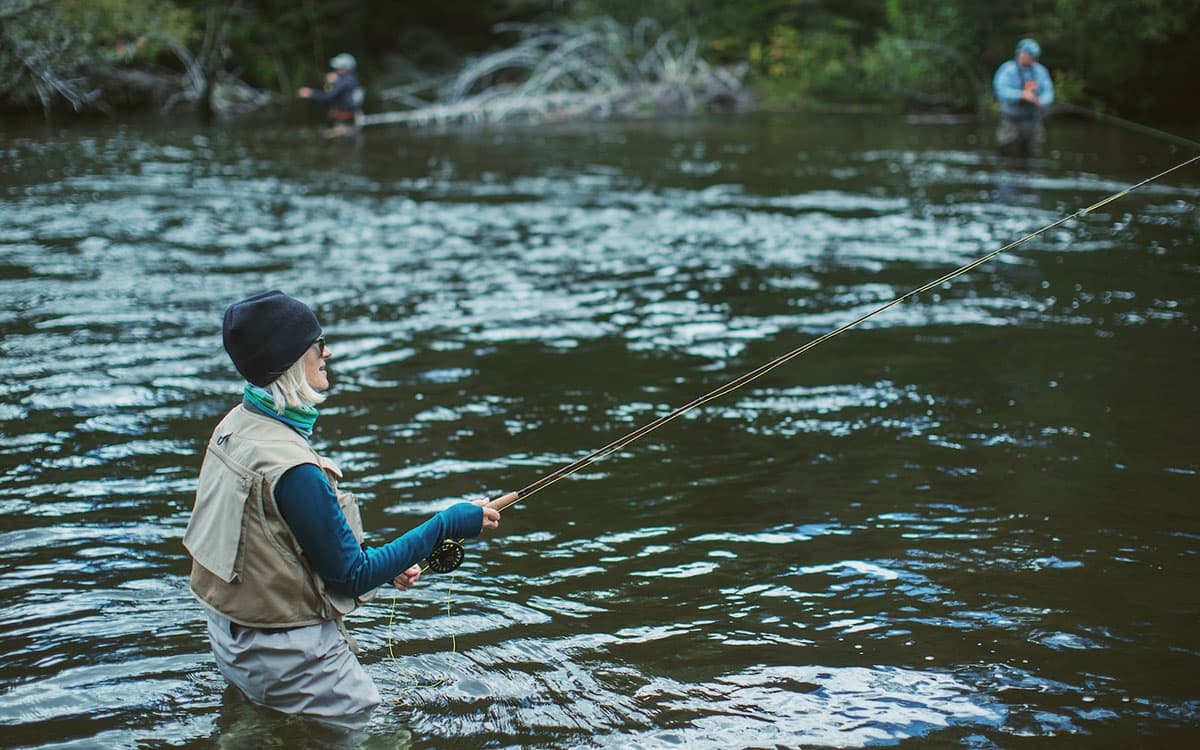

Try out your new fly-fishing gear on some brook trout in Maine’s 100-Mile Wilderness, where guests can access a panoply of remote fly-fishing-only ponds from AMC’s three lodges.
The Northeast abounds with ponds, rivers, and streams that beckon both aspiring and veteran fly-fishers alike. To get started, it’s important to know the four core components of a fly-fishing rig—rod, reel, line, and flies—and how they work together to match the conditions, and the fish, you expect to encounter.
Rods
Fly-fishing poles come in different weights, from a 0-weight up to a 9-weight rod, each of which is designed for a particular size range of fish. As weight designations increase, rods get thicker and stiffer to handle larger fish. Lower-weight rods are more flexible (or in fishing parlance, have more action) and are designed for smaller quarry. The Northeast is generally a land of smaller trout—the primary target of fly-fishers—compared to other regions of the country, with many fish falling in the 6- to 12-inch range. This makes a 5-weight rod a good all-around choice for beginners, with enough action to enjoy catching smaller fish plus enough heft to tackle larger specimens and to develop good casting technique.
Most poles are made from ultralight graphite composites, with the highest-end models adding carbon fiber into the mix. Unlike the shorter rods used for spin-casting (where anglers cast lures or bait farther out into the water), the standard length for a fly rod is 9 feet, although slightly shorter versions are available for closer conditions, where you have less room to cast. Cork handles mold to your hand over time and are more durable than the foam you’ll find in inexpensive models.
Reels
The quality of fly-fishing reels has gone up dramatically in recent years, while cost has declined; precision-crafted, lightweight aluminum models that once cost hundreds of dollars are now well within the reach of novice anglers. Reels come in various sizes and indicate the range of rod weights they are designed to work with. Die-cast aluminum is used in more inexpensive versions; higher quality precision-machined aluminum is used in pricier models. Keep in mind, however, that fly reels act primarily as line holders; even the most basic models are generally adequate for beginners. Note: A Japanese-style subset of fly-fishing, known as tenkara, skips the reel entirely.
Line
The weight of the fly line is what provides a mass for the angler to cast; a complete fly-fishing setup consists of four connected line elements. The first is called the backing, a length of strong, woven line tied to the center spindle, or arbor, of the reel. Next comes the fly line itself, which attaches to the backing. Fly lines are generally made of a braided nylon or Dacron core coated with PVC; like reels, they come in different weights to match the weight of the rod. Most float on the water, although some are designed to sink to reach fish that aren’t feeding at the surface.
The next component is the leader, a thin length of line (usually around 9 feet) that tapers from a fatter tail (the butt), where it is secured to the end of the fly line, to a smaller diameter at the farther end. Finally comes the tippet, a shorter length of lightweight line attached to the leader that is designed to be invisible to fish. This is where you tie on your fly.
Flies
The goal of fly fishing is to entice the fish with something they perceive to be food. What they think is food, however, will vary markedly by location and time of year. In general, you want the fly—typically composed of bits of thread and feathers—to resemble an insect that is swimming or hatching in the body of water you’re fishing.
There are two primary types of flies: wet and dry. Dry flies are most common; they are designed to float and are much easier to keep an eye on—a good choice for beginners. Wet flies are designed to sink and are used for a type of fly-fishing known as nymphing. There are hundreds of options, so to identify the best flies for your needs, contact the fly-fishing shop or outfitter closest to your intended destination for their advice on current conditions.
LEARN MORE:
FLIGHT PLAN
Beyond the four basics—rods, reels, lines, and flies—there are a few extra items you’ll want on the water, including:
- A way to easily carry and access your equipment, like a multipocketed vest or a waistpack.
- A pair of small scissors for trimming line. (Don’t use your teeth!) Nail clippers, fine nail scissors, or specialty fly-tying scissors are all good options. Secure them to your vest or pack with a short lanyard so you don’t lose them.
- A compact fly box for storing and sorting your flies.
- Extra line for replacing the tippet as it slowly diminishes in length from removing and tying on flies, or as you lose it to snags in the water.
- A hemostat, or tiny locking pliers, for removing the hook from the fish.
- Dry fly floatant, which you can apply to your flies to help them stay on the surface.
- A soft case for storing your fly rod and a rigid case for transporting it safely in your car or pack.
- Waders to stay dry and warm while standing in the water for easier casting. These waterproof overalls are essential if you’re wading in colder conditions.
MAKE IT A COMBO
The core components of a fly-fishing rig work together to achieve an appropriate balance and weight for effective casting. Assembling all of these pieces, however, can be challenging and expensive for a beginner. To address this, many companies offer starter, or combo, kits that include the core components, each of which is selected to work well together—a great way for newbies to get started. One of the best is the Orvis Encounter 5-Weight Outfit ($169), a good value for the quality of equipment included.